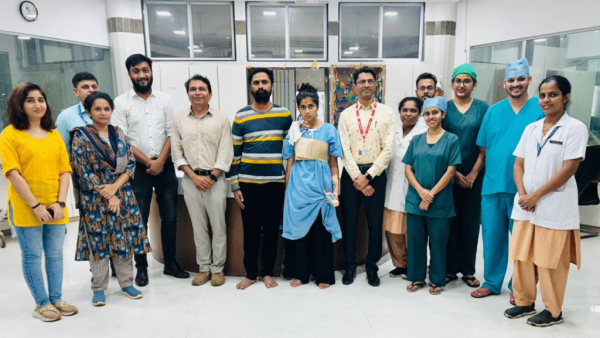
The rise of generative AI or ChatGPT-style tools is reshaping how people work, learn , create and verify information but for parents, the question is not whether AI will matter because it already does, the question is how to raise children who can use these tools wisely, responsibly and creatively. Generative AI will change many tasks but it amplifies the value of human skills hence, the best gift that parents can give their children is a toolkit that includes habits of verification or lateral reading, computational thinking, self-regulated learning, ethical judgment, socio-emotional skills and creative problem-solving. Teach those and children won’t just survive an AI future , they will shape it.
In an interview with Times of India, Dr. Sujata Seshadrinathan, Co-Founder and Director - IT and Process at Basiz Fund Services, shared, "AI is the future of the world. Many industries that were initially very cautious about its implications have after considerable research, adopted it with resounding success. The successful adoption and tremendous positive impact of AI is not only on business and economic activities but across all domains including medicine, administration, transport, travel and even education. Currently Generative AI or Gen AI has managed to overcome the initial setbacks and made great progress in creating new content with dependable analytical insights and precision."
Kids will increasingly get answers from AI and the web hence, they need habits to check whether those answers are trustworthy. Parents should turn verification into a game like after an AI answer, ask your child to find two other credible sources that confirm it then practice it together for 10 minutes a week. Teaching children the habit of quick cross-checking (looking up the claim, checking the source and comparing) reduces the risk that they will accept AI output uncritically. According to a 2019 study published in the
Teachers College Record, lateral reading teaches learners to leave the page and check what other sources say — reading less on a page and more across pages. The study showed that expert fact-checkers and skilled readers rarely trust a single webpage — they open new tabs, verify credentials and triangulate.
The student community specifically has to be cognizant of the impact and usage of Gen AI and must be educated in harnessing its power which unfortunately can be positive or negative. Asserting the same, Dr. Seshadrinathan cited, "For instance, copying the output of AI may cause plagiarism and even lead to incorrect biased information leaking into their knowledge base. One must tread with caution and remember that Gen AI information is very difficult to trace, may contain incorrect information and can be trained to remain undetected in coursework."

Over dependence on AI has already been researched for the degenerative effect it has on one’s skill and brain capabilities development. The ways to sift through and synthesise the output of Gen AI and the knowledge of best tools to be used in the right ways will make the difference between success and failure for students . Dr. Seshadrinathan opined, "Educators have to continue developing methods to encourage original thought and work on those that make it possible for them to detect output copied from AI. A lot of emphasis has to be laid on designing education syllabuses that will enable students to innovate and create new perspectives around Gen AI. The need of the hour then is to harness the power of Gen AI with great precision in order for it to be a collaborative ally not an adversary."
Parents can use everyday puzzles (recipe scaling, organising chores into algorithms, simple block coding apps) to make abstraction and stepwise problem-solving normal family practice. A 2006 study in
Communications of the ACM, found that computational thinking gives us the courage to solve problems and design systems that no one of us could tackle alone. The seminal essay argues computational thinking is a fundamental literacy for the 21st century. Kids who learn to break problems into steps and reason about algorithms will be better prepared to collaborate with AI tools and judge their outputs.
Technology is a powerful and useful tool when used thoughtfully and responsibly. What we see online is often curated by human beings - people with their own thoughts, ideas and opinions. Karishma Menon, Co-Founder and Curriculum Developer at Rangeet, asserted, "Knowing when to question what you see, check for facts and think for yourself is what makes you a smart digital citizen. What you do online should always be powered by HI (Human Intelligence), assisted by AI (Artificial Intelligence)! AI might talk like a human but it is not one! AI can sound smart or friendly but it does not have feelings, thoughts or opinions like you do. It cannot tell what is right or wrong. That is your superpower. So always use your judgment first!

Parents should teach kids how generative AI works and its limits. Explain, in kid-friendly terms, that AI predicts likely words based on patterns and it doesn’t “know” facts like a person does. Ask children to treat AI responses like drafts to be checked, not final answers. Knowing strengths (speed, summarisation) and limits (hallucination, bias, lack of true understanding) turns AI from a magic box into a usable tool. A 2024 review article in
PeerJ Computer Science established that Generative AI offers huge educational potential but introduces risks like misinformation, overreliance and distraction, which must be mitigated through instruction and policy. Recent reviews show generative AI can personalise learning and generate practice materials but it can also produce confident-sounding falsehoods and encourage shortcutting. Teaching kids about “why AI can be wrong” reduces blind trust.
When AI helps your kids to write, draw or create something cool, remember that AI learns from stuff people have already made and it might sneak in pieces of their work without permission. Menon said, "That is why you should get creative and let AI be your kids' assistant, not the star of the show! Always respect other people’s copyright, not doing so is like stealing! When you use AI, the question you have written goes to giant computer buildings called data centres. They run day and night! That is so they can run AI, store information and keep the Internet running but all this needs a lot of natural resources to work, like electricity."
That much electricity means burning fuels which in turn pollute our air, water and climate. The buildings get so hot they need huge cooling systems that are like air-conditioners and they use even more resources. Always remember: you are the real power behind technology. Menon pointed out that it is just a tool and you have to decide how to let your kids use it; with curiosity, kindness and creativity, you can help them use it for good. For example, kids can learn about their favourite animals, start a project to protect the planet, make music, games or awesome stories and spread positivity and smart thinking online! Protect our valuable ecosystems by using resources wisely.
Parents should strengthen self-regulated learning and study habits. With AI doing more information-work, kids who can set goals, plan, monitor and reflect (self-regulated learners) will use AI to amplify learning rather than avoid it. Parents should teach simple routines: set a clear study goal, ask the child to write one question they hope to answer with AI, review the AI’s reply and then summarise what they learned in one sentence. A 2017 review of self-regulated learning models in
Frontiers in Psychology stated that self-regulated learning involves goal-setting, strategic planning, self-monitoring and reflection — processes that transform cognitive abilities into academic skills. The research showed that students who actively plan, check progress and reflect learn more deeply. In an AI world, these skills help students ask better prompts, evaluate responses and integrate AI output into projects.
Generative AI is far more than building a new gadget or software; it is a fundamental shift in how we create, problem-solve and interact with information hence, our approach must therefore move beyond simple technical training to foster a deep, intuitive and responsible understanding of this technology. Bringing her expertise to the same, Shreya Krishnan, MD - India at AnitaB.org, suggested a few foundational tips for preparing students for a future with Generative AI:
Prioritise 'why' over 'what' by cultivating critical interrogation skills
The most crucial skill shifts from finding the right answer to asking the right questions. Students must be taught to treat AI not as an oracle, but as a powerful—yet flawed—research assistant that requires rigorous supervision. In classrooms, assignments should be redesigned. For instance, instead of asking for an essay on a topic, task students with using a GenAI tool to generate a first draft. Their primary work is to then dissect this draft. They must fact-check its claims, identify inherent biases (e.g., a Western-centric perspective, gender biases, etc.), challenge its assumptions, and evaluate the depth of its analysis.
The final grade should be based on this critical interrogation and their subsequent human-led refinement, not on the AI's initial output. This builds an essential research-led, curious mindset.
Build an unshakable foundation in core concepts and ethics
AI is brilliant at synthesising information that already exists but it cannot replace deep, foundational knowledge. This is the bedrock upon which students can build with AI, rather than be replaced by it. A student who doesn't understand basic programming logic won't be able to correct AI-generated code; one without a firm grasp of historical causality won't be able to spot the AI's oversimplification of complex events. Ensure curriculum strengthening in core subjects like mathematics, logic, scientific method, history and language arts. Simultaneously, integrate dedicated modules on AI ethics. Discuss real-world cases: bias in hiring algorithms, copyright issues with AI-generated art and the environmental cost of large AI models.
‘The person who has the knife decides it’s usage’ - this is something that needs to be instilled in students. Students must understand the societal impact of the tools they use.
Foster human-centric skills through creativity, empathy and collaboration
Generative AI excels at pattern recognition and recombination. It struggles with genuine novelty, profound emotional intelligence and the nuanced dynamics of human collaboration. These are the skills that will become the ultimate differentiators. Design project-based learning that AI can assist but not complete. For example, have student teams use AI to generate market research data or initial design mockups for a project solving a local community problem (e.g., reducing plastic waste in their neighbourhood). AI provides the scaffolding but the human work is in interviewing community members (empathy), brainstorming truly innovative solutions (creativity), negotiating ideas within the team (collaboration) and presenting their findings with passion (storytelling). This teaches students to leverage AI as a tool to amplify their uniquely human strengths.
Demystify the technology by promoting hands-on tinkering and understanding
Fear and mystification are barriers to empowerment. We must move AI from being a magical black box to an understandable technology, demystifying its capabilities and limitations through direct, hands-on experience. Introduce basic concepts of how AI models are trained on data through simple, relatable exercises. For older students, use low-code platforms to let them train a simple image-classification model themselves. Let them see how the quality and bias of the data they feed it directly affects the output. This practical experience is the best vaccine against both the hype and the fear surrounding AI, fostering a generation of informed users and creators.
Instil a mindset of adaptability and lifelong learning
The specific tools and platforms of today will inevitably evolve or become obsolete. Therefore, preparing students isn't about teaching them how to use ChatGPT; it's about equipping them with the mental flexibility to adapt to whatever comes next.
The classroom culture must shift from one of providing answers to one of nurturing curiosity. Reward students for exploring new AI tools, for sharing their findings on what a new model can or can't do, and for analysing the long-term implications of this technology. Teach them how to learn, unlearn, and relearn. Highlight stories of resilience and reinvention. This mindset will allow them to navigate not just the future of AI, but the entire uncertain future of work.
These steps can help forge a generation that does not just use AI but shapes it with wisdom, ethics and a profound sense of humanity.
-
Success in removing the cancer of a 6 -year -old girl, overcomes a debilitating illness

-
Learn how much food is right in 1 day? – Obnews

-
Dhunuchi Dance of Durga Puja: Story behind sacred dance ritual explained

-
What is the best in Sweet Corn and Desi Bhutta, know the matter before intake for weight loss

-
Amazon Great Indian Festival 2025: This is the best day! Buy at the lowest price so far Apple Mac Mini 2024
